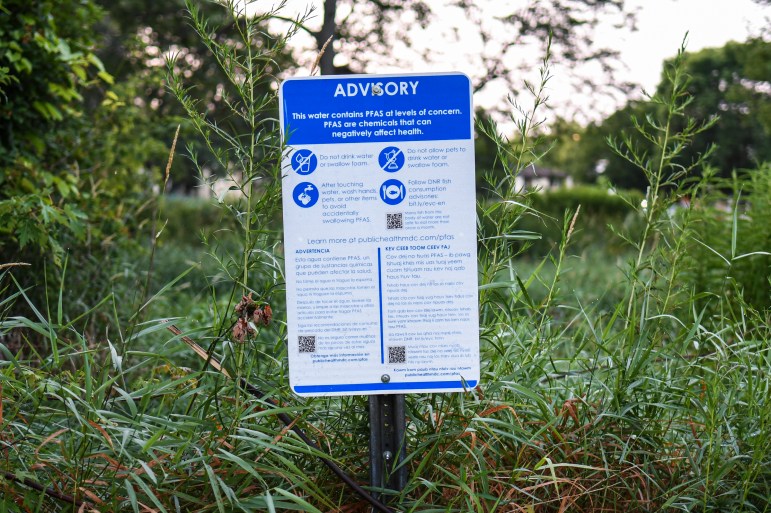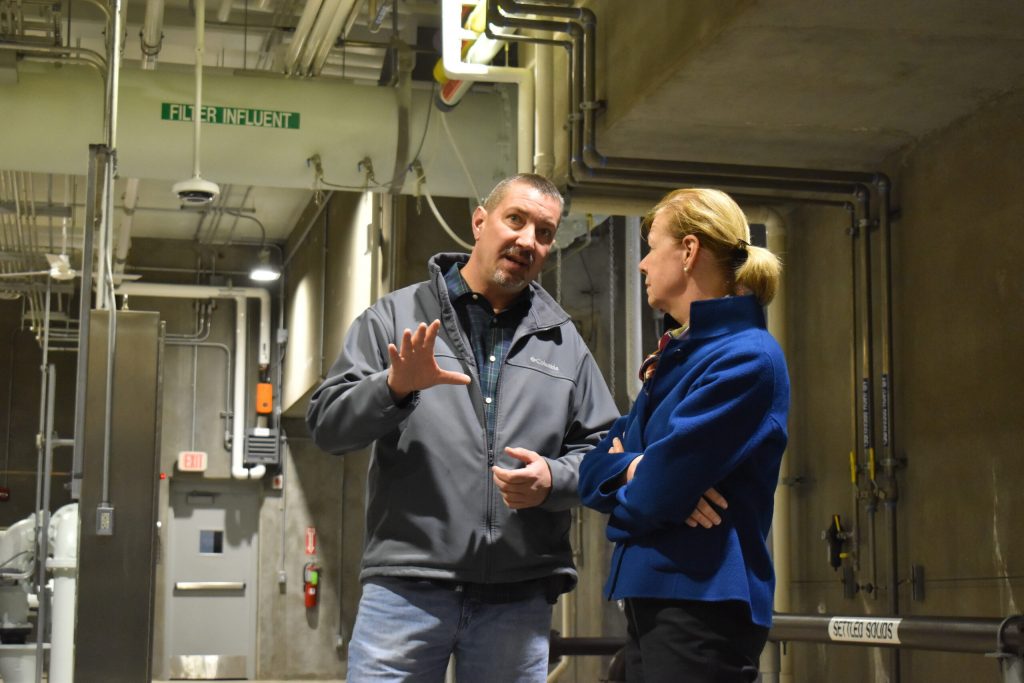Wisconsin Officials Unhappy With EPA Plan To Weaken PFAS Standards
Rolling back or delaying some standards set under Biden administration.

A sign warning of PFAS risks in Starkweather Creek in Madison, Wis., is posted along the creek at McCormick Park on July 20, 2021. Starkweather Creek is contaminated with PFAS, a group of human-made “forever chemicals” that accumulate in the body and persist in the environment without fully breaking down. Research has linked the substances to low birth weights, immune system challenges, thyroid problems, certain cancers and more. Isaac Wasserman/Wisconsin Watch
Wisconsin residents and environmental advocates say the Environmental Protection Agency’s plans to weaken drinking water standards for PFAS will harm public health. But water utilities say it gives them more time to comply.
The EPA announced Wednesday that it plans to keep drinking water standards for two of the most widely studied PFAS, but the agency is pushing out the deadline for water systems to meet those limits from 2029 to 2031.
“This is terrible news for public health,” Oitzinger said. “It’s terrible news for the environment.
”Last year, the Biden administration set individual limits for PFOA and PFOS at 4 parts per trillion, which is roughly 17 times lower than the state standard of 70 parts per trillion. The Trump administration is keeping those standards in place. But the administration is scrapping and reconsidering limits for three other PFAS that include GenX chemicals, as well as a mix of four other PFAS substances.
Environmental groups praised PFAS standards when they were finalized last year, but water utilities sued over the new regulations. Environmental advocates at Clean Wisconsin say the EPA’s justifications for the change align with utilities’ stance that the agency lacked authority to regulate the chemicals or that current science doesn’t support the limits.

Marinette Common Council member Doug Oitzinger stands over a ditch flowing into Green Bay where water samples have shown PFOS levels as high as 2,000 parts per trillion before it’s treated. Danielle Kaeding/WPR
Sara Walling, the group’s water and agriculture program director, said it’s good to see the EPA will maintain standards for PFOA and PFOS. Even so, she said, rolling back regulations for other chemicals and delaying compliance is frustrating.
“Pushing the timeline back any little bit, it really just means that there’s a longer timeframe within which people are going to be drinking PFAS within the water that they’re provided by their municipal system,” Walling said.
Per- and polyfluoroalkyl substances, or PFAS, are a class of thousands of synthetic chemicals that are used in everyday products like nonstick cookware, stain-resistant clothing, food wrappers and firefighting foam. The chemicals don’t break down easily in the environment. Research shows high exposure to PFAS has been linked to kidney and testicular cancers, fertility issues, thyroid disease and reduced response to vaccines over time.
EPA Administrator Lee Zeldin said in a statement the agency will protect Americans from PFOA and PFOS in their water and hold polluters accountable.
Chris Groh, executive director of the Wisconsin Rural Water Association, said he thinks the changes are reasonable.
“It’s giving the rural plants time to comply with all the things that need to go into it, and then make it affordable,” Groh said.
He said systems need more time to identify and install technologies to treat the chemicals, as well as how to safely dispose of filters or waste from removing PFAS. Environmental advocates argue technology already exists to capture and remove the chemicals.

Wausau drinking water superintendent Scott Boers speaks with U.S. Sen. Tammy Baldwin during a tour and press conference at Wausau’s newly opened water treatment facility, which is removing PFAS from city water, Friday, January 13, 2023. Rob Mentzer/WPR
Three years ago, the city of Wausau discovered elevated PFAS levels in all six city wells. The city implemented a temporary fix before borrowing just under $17 million for a granular activated carbon filtration system to remove the chemicals, which came online late 2024.
Wausau Mayor Doug Diny said PFAS levels are now almost undetectable in the city’s water supply and meet federal standards. However, he said installing costly treatment may not be possible for smaller cities.
However, President Donald Trump has proposed gutting state loan programs that fund water projects like PFAS treatment or other infrastructure needs. Without funding, Groh said it may take even longer for systems to find money or raise rates to comply with federal standards.
Walling added the change may hinder the state’s ongoing efforts to develop groundwater standards for PFAS in line with levels proposed by the Biden administration. The state has twice failed to set limits for the chemicals in groundwater. Communities like the towns of Peshtigo, Stella and Campbell are struggling with PFAS contamination of private wells that draw from groundwater.
Gov. Tony Evers proposed a $145 million plan to address PFAS in the next two-year state budget, but Republican lawmakers on the state’s budget-writing committee stripped those items along with hundreds of others. In 2023, Evers and lawmakers set aside $125 million in a trust fund to help PFAS-contaminated communities address the chemicals, but they’ve yet to agree on how to spend those funds.
Wisconsin residents, groups frustrated with EPA plan to weaken PFAS standards was originally published by Wisconsin Public Radio.
If you think stories like this are important, become a member of Urban Milwaukee and help support real, independent journalism. Plus you get some cool added benefits.
More about the PFAS Problem
- Bipartisan Push to Tell Counties Faster When Water Tests Fail - Henry Redman - Dec 19th, 2025
- MKE County: County Seeks to Sue PFAS Producers, Oil Companies - Graham Kilmer - Dec 10th, 2025
- Wisconsin Reviewing EPA-Approved Pesticides For PFAS - Danielle Kaeding - Dec 9th, 2025
- State Nears Settlement with Johnson Controls/Tyco Over PFAS Spills - Danielle Kaeding - Dec 4th, 2025
- Senate Bill Promotes Soybean-Based Firefighting Foam to Replace PFAS - Danielle Kaeding - Dec 2nd, 2025
- Test Results Show High PFAS Levels in Wisconsin’s Landfill Runoff - Danielle Kaeding - Dec 2nd, 2025
- Wisconsin Communities Get $282 Million for Drinking Water Projects - Danielle Kaeding - Nov 19th, 2025
- Gov. Evers, DNR Announce $282 Million to Improve Drinking Water Quality for Wisconsinites in 74 Municipalities - Gov. Tony Evers - Nov 18th, 2025
- Cleanup of PFAS Could Cost Wisconsin Billions - Danielle Kaeding - Nov 13th, 2025
- Cleanup PFAS Without Penalizing Innocent Landowners - Wisconsin Manufacturers & Commerce - Nov 4th, 2025
Read more about PFAS Problem here





















Another outrageous step toward destroying our health and protecting polluters. Disgusting!